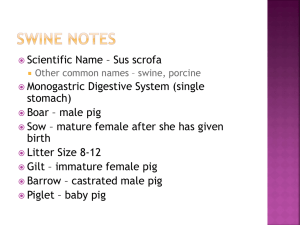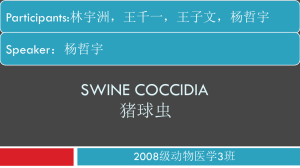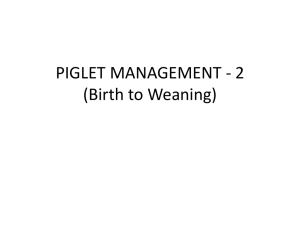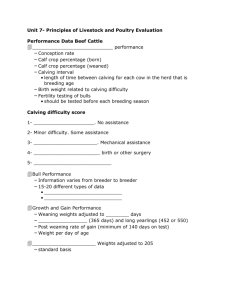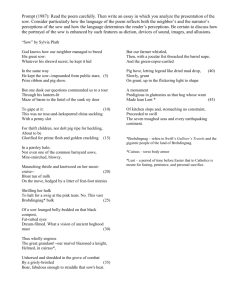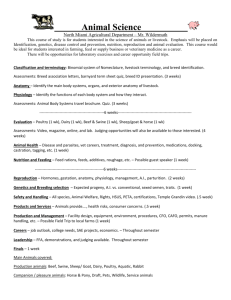Section 3: Reproduction, By-Products, Animals Close
advertisement
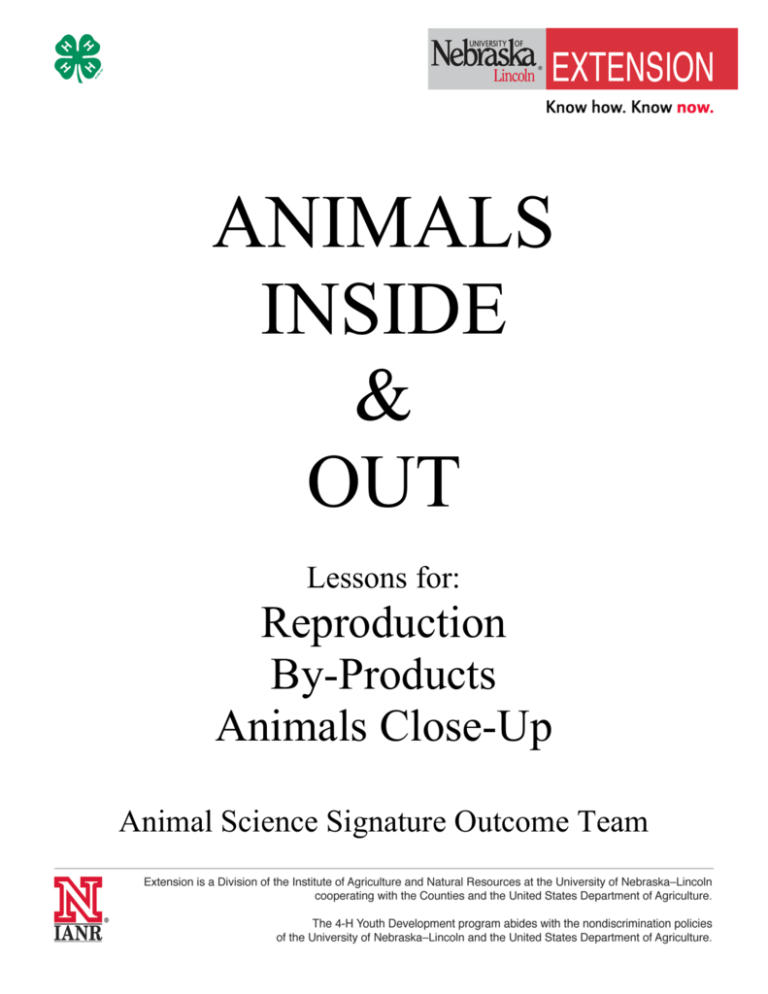
ANIMALS INSIDE & OUT Lessons for: Reproduction By-Products Animals Close-Up Animal Science Signature Outcome Team Lesson Title: Animal Reproduction Field Day (2/21/15) Lesson By: Ashley Benes and Dr. Bryan Reiling Subject Matter Area(s): Student will be able to name the differences between reproduction in cattle and swine, and identify the major parts of the sow and cow reproductive tract. Grades: 3-5 Time involved: 30 min Careers: Animal Geneticist, Animal Breeding Specialist, Rancher/Producer Introduction: Has anyone in this group seen an animal being born? What kinds? Anyone seen a piglet or calf being born? Today we’re going to talk about animal reproduction and we are mostly going to discuss cattle and pigs. How big is piglet when its born? (3-4 lbs) How big is a calf when it’s born? (70-100 lbs) (Can also talk in terms of actual size and use hands to show the length and height of each) How many calves does a cow give birth to at once? (1-2) How many piglets does a sow give birth to at once? (1-25) What other animals give birth to multiple babies at once? Dogs, Cats, Rabbits, rodents—these are called litters. So the main differences in cattle and pig reproduction are: 1. Size of the babies, 2. Number of babies and 3. Length of Gestation. Who can tell me what gestation means? The length in days from conception to birth…so how long the animal is pregnant before giving birth. Which do you think has a longer gestation, pigs or cattle? Cattle! It’s usually easy to guess- the larger the animal the longer the gestation. Cattle- 9 months 10 days or 280 days Swine- 3 months, 3 weeks, 3 days or 114 days Sheep- 152 days Goats- 150 Horses- 340 days or just longer than 11 months Dogs- 63 days on avg Elephant- 547-669 days or two years! **A lot of these times depend on other factors like the breed of the animal We are going to do an activity with some animal body parts. Feel free to touch and look as closely as you want. If you are a bit squeamish or it makes you uncomfortable, feel free to step away. No one will make fun of you. Make sure if you need to step away you tell my or a teacher so we know where you are. Activity1: Swine and Beef Reproduction (20 min) Materials: - Trays - Fresh/Frozen and Thawed Swine reproductive tracts (can get from UNL campus or Hormel) - Fresh/Frozen and thawed Beef reproductive tracts (can possibly get from UNL campus or local locker) - Preserved adult Sow tract ( may be able to borrow from UNL campus) Otherwise utilize photos - Latex free disposable gloves - Wet paper towels to cover repro tracts - Handouts for additional discussion on fetus size or can be used if you don’t have a preserved tract Preparation: - Lay out reproductive tract so the sow/gilt tracts are on tables separate from each other and so all parts are laying correctly. - Split groups larger than 10-12 into two separate groups with 2 instructors. One instructor for Swine and one for Beef and switch groups part way through. Swine: - Point out the following parts: o Uterine horns- Why do they look different? Where do the piglets stay until they are born? o Ovaries- Where eggs are produced. Ovaries have follicles that burst and produce and egg. The egg is released and gets fertilized by the boar’s semen creating a pregnancy. o Cervix- Tough, cartilaginous material. Inside is the shape of a corkscrew. This helps to keep any dirt and bacteria out of the uterus. Why is that important? So that no infection can get into the uterus and harm and piglets that might be in there. **Discuss the Pregnant sow preserved tract. Note the differences in size from the gilt tracts..why? Those were younger animals that had never been and weren’t currently pregnant. The preserved tract shows a piglet inside a uterine horn cell with umbilical cord still attached. This piglet is about a pound. How big are piglets when they’re born? 3-4 lbs. So how large would a sow have to be to have this many piglets inside her? Really Big! Let’s count the number of piglets this sow was pregnant with…let the kids count in the uterine horns by feeling them. 16-17 piglets should be what they feel. Beef: - Point out the following parts: o Cervix- Cervix- Tough, cartilaginous material. o Uterus- Why is this so much smaller than the sow? Only one or two calves. You can still see there are two uterine horns. Are they symmetrical? One is usually larger than the other. o Ovaries- These also look different than the swine but they serve the same purpose. Where eggs are produced. Ovaries have follicles that burst and produce and egg. The egg is released and gets fertilized by the bull’s semen creating a pregnancy. You can usually feel a follicle on the ovary. **How can we tell if this animal is pregnant? We can do an ultrasound like we would with people or you can do what we call preg-checking. We do this through rectal palpation- Inserting an arm into the rectum and palpating or feeling the uterus. As a pregnancy grows, the uterus becomes larger and fluffy or feeling like its more full of liquid. This is how large the calf is at certain points during pregnancy: 2 months- size of a mouse 3 months- size of a rat 4 months- size of a small cat 5 months- size of a large cat 6 months- size of a small dog 7 months- size of a Beagle **Based on this, when does a calf do most of it’s growing in the uterus? They get to be 70-100 lbs when they’re born. Compare some photos of pregnant beef tracts and the sizes to determine how far long the cow was. Conclusion: What are the major differences in different animal species reproduction? So the main differences in cattle and pig reproduction are: 1. Size of the babies, 2. Number of babies and 3. Length of Gestation. What are the gestations of the animals we talked about? Cattle- 9 months 10 days or 280 days Swine- 3 months, 3 weeks, 3 days or 114 days Sheep- 152 days Goats- 150 Horses- 340 days or just longer than 11 months Dogs- 63 days on avg Elephant- 547-669 days or two years! **A lot of these times depend on other factors like the breed of the animal What careers would need to work with or worry about animal reproduction? Farmer, rancher, animal geneticist, animal breeding specialist Lesson Skills and Standards Science SC5:3.1.b Identify how parts of plants and animals function to meet basic needs (e.g. ,leg of an insect helps an insect move, root of a plant helps the plant obtain water) SC5.3.2.a Identify inherited characteristics of plants and animals. SC5.3.2.b Identify the life cycle of an organism. SC5.3.3.c Recognize the living and nonliving factors that impact the survival of organisms in an ecosystem SC5.3.4.a Describe adaptations made by plants or animals to survive environmental changes Social Studies SS 3. 2.2.a Classify natural, human and capital resources (e.g., tools, soil, water, farmers and machinery) SS 3. 2.2.b Discuss why producers combine resources to make goods and services SS3. 3. 3. a Compare and contrast local places and regions with other places and regions (e.g., prairie and forest, local community with another community, products from Nebraska and another state, crops grown in NE and another state) SS4.2.12.a Compare Nebraska with different regions and the goods and services each region produces (e.g., beef, wheat, telemarketing, cotton, coal) Language Arts LA 3.3.1. a Communicate ideas and information in a clear and concise manner appropriate for the purpose and setting (e.g., language, word choice, sequence, relevance) LA 3.3.1.b Demonstrate speaking techniques for a variety of purposes and situations LA 3.3.2.a Demonstrate listening skills needed for multiple situations and modalities (e.g., electronice, one-to-one, small/large group, presentation) LA 3.3.2.d Listen to and summarize thoughts, ideas, and information being communicated LA 4.3.2.a Communicate ideas and information in a clear and concise manner appropriate to the purpose and setting LA 4.3.1.b Demonstrate speaking techniques for a variety of purposes and situations LA 4.3.2.a Demonstrate listening skills needed for multiple situations and modalities (e.g., electronic, one-to-one, small/large group, presentation) LA 4.3.2.b Listen, ask questions to clarify and take notes to ensure accuracy of information LA 4.3.2.c Listen to, summarize and explain thoughts, ideas and information being communicated LA 4.3.3.c Interact and collaborate with others in learning situations by contributing questions, information, opinions, and ideas using a variety of media and formats Reproductive Tract of a Cow Lesson Title: Exploring By Products –Additional Activity (Created 10/29/14) Subject Matter Area(s): Learn all about the usefulness of all parts of an animal. Grades: 3rd-6th Careers: Veterinary Science Description of Activity: Youth will explore the products and by products of animals through game activity. Time Involved: 10 minutes Required Materials: Pictures of various animal by-products from these categories: • Gelatin • Hide • Bones, hooves & horns • Organs • Fat Manila envelopes labeled with the above categories What is the lesson objective? Student will look at the pictures of the by-products and determine which part of the animal the by-product was made or came from. Procedure: 1. Give each participant a picture of a by-product or more than one depending on group size. 2. Place the manila envelopes on the table where each participant can see them. 3. Instructor asks each participant what their picture is and which part of the animal they think it originated from. 4. The student puts the picture in the corresponding envelope and waits as the others do the same. 5. After all the pictures have been placed in the envelopes, the instructor goes back through them with the group and gives the correct answers. Check for Understanding: 1. When we harvest an animal we use 99.9% of it for food and by-products. In history, what group of people did the same thing with buffalo? Native Americans 2. What are some examples of by-products that we get from livestock? Leather, cosmetics, jello, marshmallows, paintbrushes, soap, lotions, medicines, etc. 3. What term do we use to describe all the products that could be used for something other than meat? By Product 4. What does the term dressing percentage mean for an animal? The percent of the animal’s weight that is considered meat. Show and tell: Show examples of the products made from by products, view the byproducts handouts and discuss each. Gelatin Hide Bones, Hooves, Horns Organs Fat Answers: Organs Tripe-Stomach Insulin/Medications Natural Casing Sausages Hide Boots Paintbrush Football Bones, Hooves & Horns Glue Bone China Buttons Gelatin Gummy Bears Jello Marshmallows Fats Detergent Lotion Lipstick Lesson Title: Animal Close-Up Field Day (Revised 2/20/15) Subject Matter Area(s): Learn about animals as you get close-up and personal. Learn the breed, gender, feeds and care of different species of animals. Learn about safety around animals. Grades: 3-5 Careers: Farmer/Rancher, Feedlot Rider, Feed and Nutritionist Time Involved: 30 min Materials: 3-4 Animal Species What is the lesson objective? Students will be able to identify the species of animals, what they eat, what breed they are and how to care for these animal species. Preparation: Find Volunteers to bring in 3-4 animal species. Introduction to Activity: You are going to have the opportunity today to see some different animals that maybe you have seen before and maybe you have not. We are going to talk about each of these animals, find out what breed they are, what they eat and what it takes to care for them. Another important aspect of taking care of animals is that you need to learn some basic safety rules when handling animals or being near them. Activity: (Use caution around animals at all times and make sure you are aware of where the students are in relation to the animals.) With each species of animals talk about: Species Breed Sex Care Feeds Shelter Safety Careers Make sure you allow time for students to pet the animals(if appropriate)!
